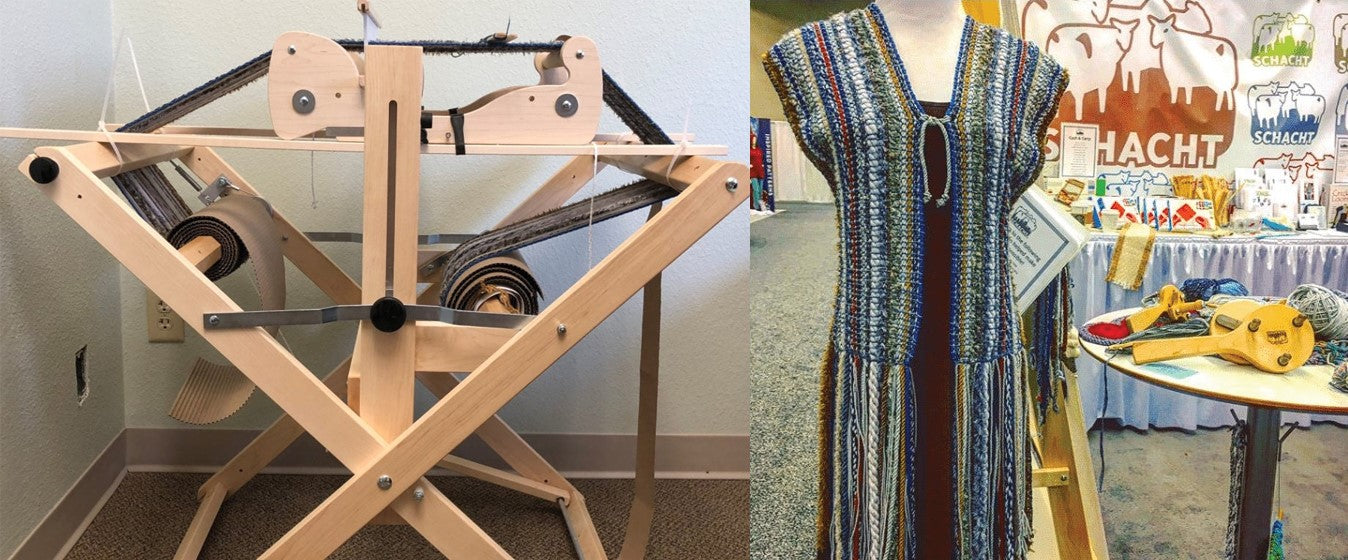By Benjamin Krudwig
"Creative, innovative, exciting, and new, all come together in this wonderful woven rope vest from designer Benjamin Collyn Krudwig and Schacht Spindle Company." —Barry Klein of Trendsetter Yarns.
These were the words uttered during the Summer TNNA (The National Needle Arts) fashion show in Cleveland as the Fringed Woven Rope Vest adorned the runway (watch the video). This woven garment created quite the stir: it combined yarns from 14 different companies in one piece, and it was one of only 2 woven garments in the show. After the enthusiastic reception it received in Cleveland, I wanted to share the process of how I made it!
Making the Ropes for a Rope Vest
For this project, we wanted to showcase the Incredible Rope Machine. Plus I had so many great yarns to inspire me! I decided a fringed vest would honor the texture and personality of each yarn. First, I measured out 20 feet between the separator clamp and the rope machine, marking the spot with tape, and made my ropes from this position every time. Due to variable take-up during the rope-making process, most of my ropes were 16 to 18 feet in finished length.
Each rope was a different thickness, ranging from a worsted-weight size up to a super chunky. For most of the yarns, I only did one pass around the rope machine, but for some of the really thin yarns, I chose to do 2-3 passes. These big ropes called for a 5-dent reed and a 10" Cricket Loom. I threaded each rope in a slot and then doubled sportweight yarn from Manos del Uruguay in the holes.

Though I have gotten over 5 yards of warp on my Cricket Loom in the past, I realized halfway through warping that the entire warp-length was not going to fit on my beam, due to the bulkiness of the rope warp yarn.
When I brought this problem up to Barry Schacht, he suggested that we strap the Cricket Loom onto the frame of a Wolf Pup loom, using the Pup's warp and fabric beam to hold the materials. (Some of the ropes were too thick to fit through an inserted eye heddle, so cutting straight to a floor loom would not have worked.)

If I had made two batches of ropes for two warps that were half the length, I could have woven each piece separately on the Cricket Loom. But I didn't - I made one long warp so I could weave the panels end to end.

I left 2 feet of warp for fringe at the beginning of my weaving, then wove in plain weave for 4 feet with Gerty, a fingering weight yarn from Anzula Luxury Fibers. I then left 4 feet of warp for fringe and wove 4 more feet of plain weave ending with 2 feet of fringe at the end. I hemstitched at the beginning and end of each woven panel.
Once all of the fabric came off the loom, it was time to cut the two panels apart. This required cutting each rope individually and knotting the ends to prevent fraying.
To construct the vest, I laid the fabric panels side by side, lining up the hems. I seamed them together at the back, stopping just before the halfway mark. At this point I crocheted a small triangle of lace to create a much more natural and comfortable neckline. After constructing the vest, I then soaked it in hot water, then laid it flat to dry.

Overall it was an absolutely amazing experience to work with so many wonderful yarns from so many companies, and bring them all together in one piece using Schacht products in new ways. I look forward to weaving more projects using unconventional materials and methods!
Thanks to the following yarn companies:
Anzula
Berroco
Brown Sheep Co.
Classic Elite Yarns
Fairmount Fibers/Manos del Uruguay
Filatura di Crosa
Frabjous Fibers
Knitted Wit
Prism Arts, Inc.
Round Mountain Fibers
Skacel
Sugar Bush Yarn Company
Trendsetter Yarn Group
Universal Yarn

